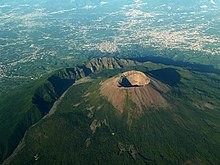MOUNT VESUVIUS

Disclaimer: Copyright infringement is not intended
Context
- When Mount Vesuvius erupted in Herculaneum in AD79, it buried the Roman town in ash and pumice and destroyed hundreds of antique scrolls in the library.
- The scrolls are riches for historians, who may soon be able to understand them thanks to artificial intelligence.
About
- It is an active volcano in southern Italy that rises above the Bay of Naples on the Campania plain.
- It is the only active volcano on the European continent.
- Because its eruptions often include explosive eruptions as well as pyroclastic flows, the volcano is classed as a complex stratovolcano.
- A pyroclastic flow is a dense mixture of hot lava, pumice, ash, and volcanic gas.
- It is well known for destroying the Roman cities of Pompeii and Herculaneum in 79 AD.
- It is part of the Campanian volcanic arc, which is a chain of volcanoes formed by the convergence of the African and Eurasian plates.
- This subduction zone runs the length of the Italian peninsula and is the origin of volcanoes such as Mount Etna, the Phlegraean Fields (Campi Flegrei), Vulcano, and Stromboli.
- The lower section of the subducting slab has torn and divorced from the top part under Vesuvius, forming a "slab window."
- As a result, the rocks erupting from Vesuvius are slightly different chemically from the rocks erupting from the other Campanian volcanoes.
|
PRACTICE QUESTION With reference to Mount Vesuvius, consider the following statements:
|




1.png)
